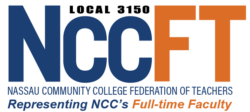Central to the principle of shared governance is the idea that curricular and other academic concerns should fall under the purview of the faculty. The logic is not hard to follow. We are the ones who deal with students on a daily basis, both in and out of the classroom; we are the ones whose job it is to stay current in the fields that our expertise qualifies us to teach; and so we are the ones in the best position to decide what the content of a college education should be. Here at Nassau Community College, our unwavering commitment to this aspect of shared governance has resulted in an academic program widely recognized as one of the best among the nation’s two-year institutions. The seamless transfer requirements that have been adopted by SUNY (Seamless Transfer) threaten the integrity of this program—and of two-year college programs SUNY-wide—by taking significant curricular decisions out of the hands of faculty and imposing, from the top down, an academic structure that privileges increased graduation rates over quality instruction.
According to SUNY, Seamless Transfer, which is to be implemented by 2015, will make it easier for students to move on from two-year to four year SUNY institutions. However, faculty across the SUNY system have serious reservations about the initiative. As recently quoted in Darryl McGrath’s article for NYSUT United, “PSC, UUP, Community Colleges Push Back on Plans that Will Dilute Quality Higher Education,” for example, United University Professions (UUP) Vice President for Academics, Jamie Dangler said, “SUNY has not adequately involved faculty in discussions about Seamless Transfer’s implications for the quality of our educational programs…. This is being imposed from above, rather than vetted through the curriculum review process that should start at the academic department level.”
One major concern is this: Under Seamless Transfer, students who cannot find a course they need on their home campus must be permitted to take that course at another SUNY campus, either online or in person. While taking such courses at other colleges and then transferring the credits back to a “home institutions” is a not uncommon practice among students, the fact that SUNY wants to allow this practice online raises the specter of MOOCs, massive open online courses, in which many thousands of students can enroll at the same time and which SUNY envisions as potentially accounting for as much as one third of a graduating student’s credits. Whatever else may be true about MOOCs, however, they are untested as a means for delivering credit-bearing instruction or for evaluating student work in response to that instruction. As such they raise a number of concerns, including but not limited to:
- Their potential for the watering down of what we mean by a college education
- Their potential for further removing control of the curriculum from classroom faculty
- Their potential for reducing the need for (particularly full-time) classroom faculty, since one professor will be able to teach so many students at one time
The questions raised by MOOCs deserve a series of posts on their own, and such posts will follow this one. For now, consider that MOOCs represent a trend of curricular standardization that is more in keeping with the educational reform agenda funded by private organizations, such as the Lumina and Bill and Melinda Gates Foundations, than with the democratizing force that public education has been in the United States since long before the beginning of the 20th century. Equally to the point, this standardization is backed by corporations like Pearson and Coursera, with which SUNY has partnered to offer its own MOOCs and which see MOOCs as an inexpensive and very lucrative source of revenue.
This question of standardization has raised serious concerns among SUNY community colleges, since Seamless Transfer requires them to fit many, and perhaps all programs into a 64-credit limit. The challenges of figuring out how to do that without cannibalizing parts of their program offerings has people seriously worried. Degree programs at community colleges already strike a delicate balance between and among the demands of general education, the disciplinary requirements of specific majors, the curricular decisions of individual departments, and the value of the degrees that community colleges award. Having to recalibrate that balance within smaller and strictly enforced parameters has the potential for setting disciplinary areas, departments, and individual faculty against each other in ways that will only undermine the institution and ultimately hurt students. As Ellen Shuler Mauk, past president of the Faculty Association of Suffolk Community College, put it, “We might have people saying, ‘Why do we have nine required English credits? We’ll lop off three.’ Or, cut out all physical education credits.”
Here at Nassau, as vice president for classroom faculty Frank Frisenda says in the NYSUT article, the pressure by the administration to meet the 64-credit requirement has been “especially pronounced” because our acting president seems eager to comply with the Seamless Transfer initiative. The NCCFT and the Academic Senate have been hard at work crafting a response to Seamless Transfer, which you will be hearing about soon. In addition, Frank, along with other community college union leaders, representatives from UUP, NYSUT, and CUNY’s Professional Staff Congress (PSC), who are dealing with CUNY Pathways, an initiative very similar to Seamless Transfer, met this summer to discuss ways of educating people across SUNY and CUNY about the negative effects of these initiatives. This blog post, and the ones that will follow, are part of that effort.
Initiatives like SUNY’s Seamless Transfer and CUNY’s Pathways have the potential to transform public higher education in ways that directly contradict its democratizing mission. It is crucial that you be informed as possible about what’s happening. Here are some links for further reading:

2 Responses